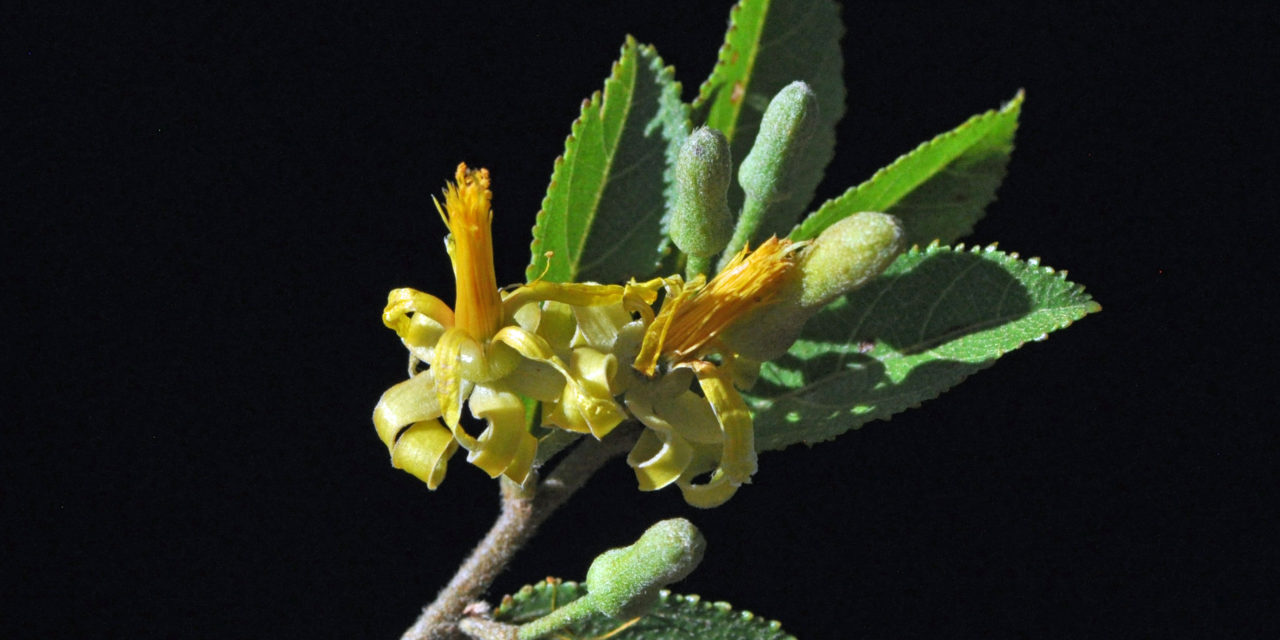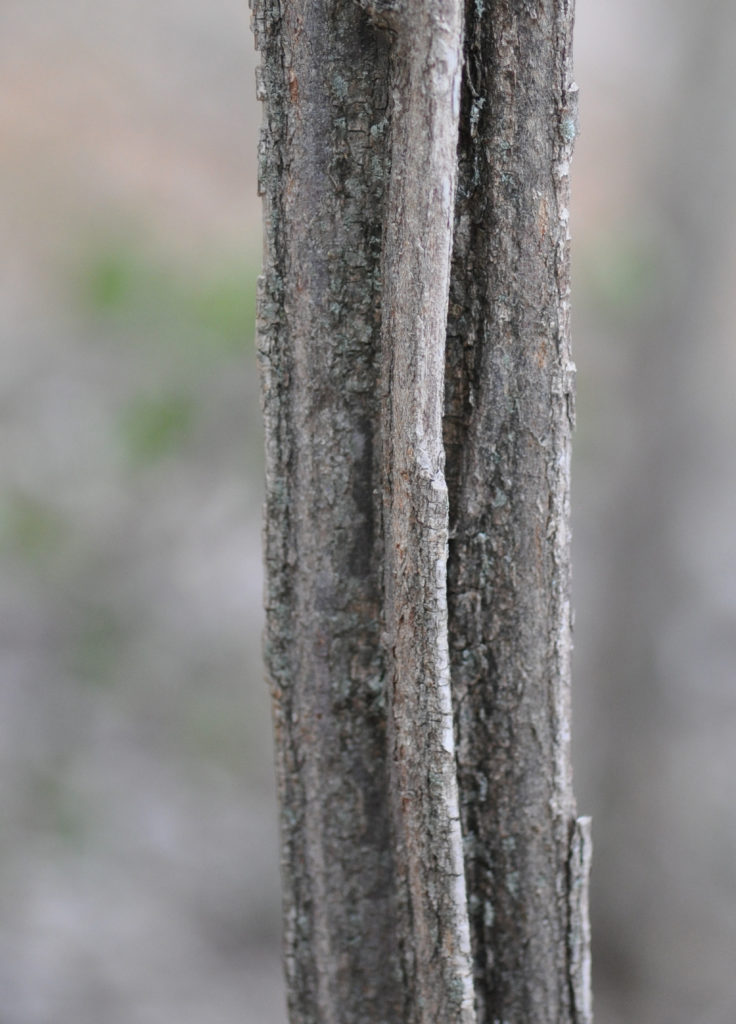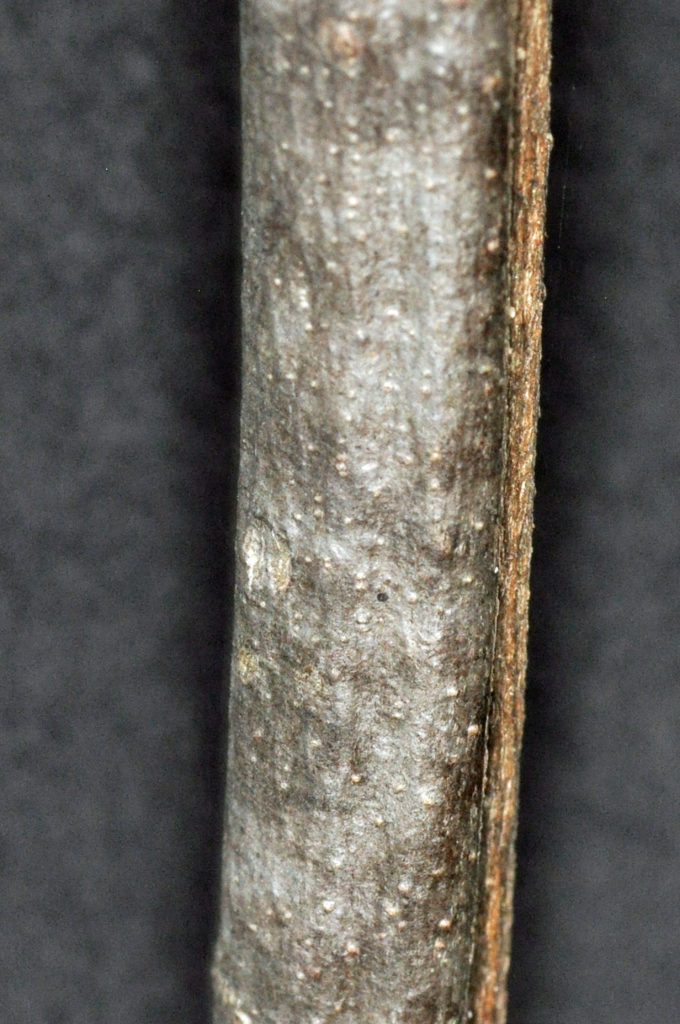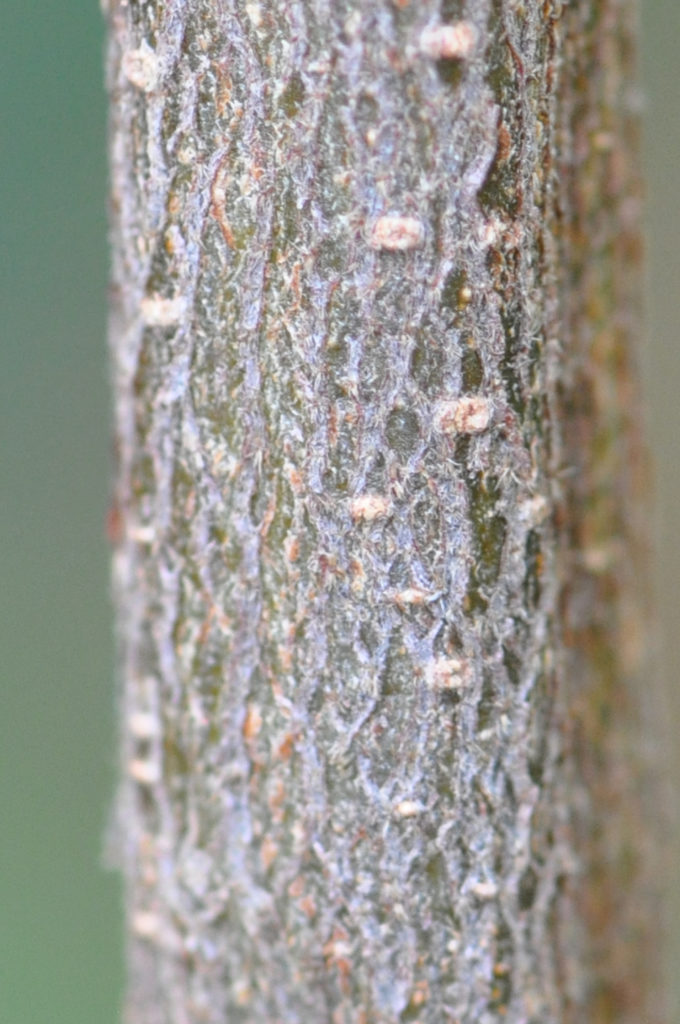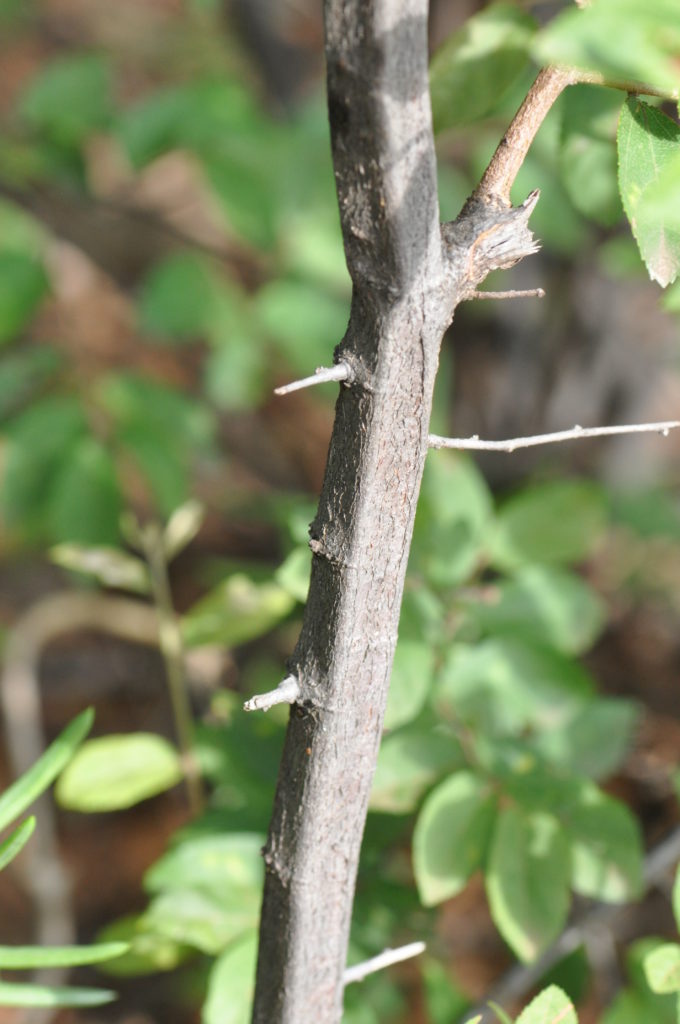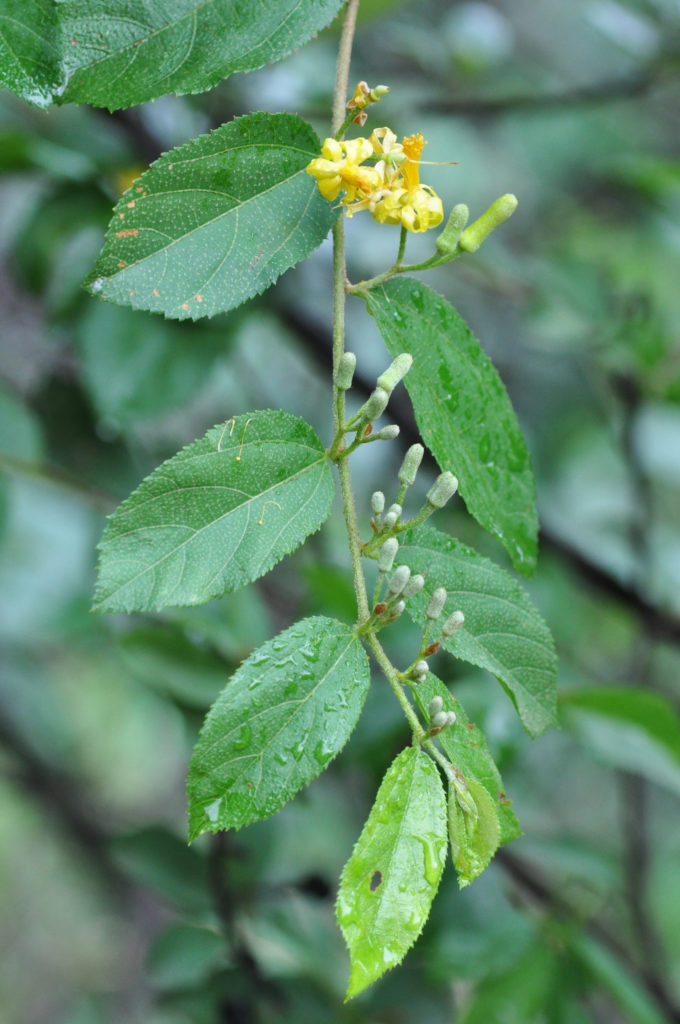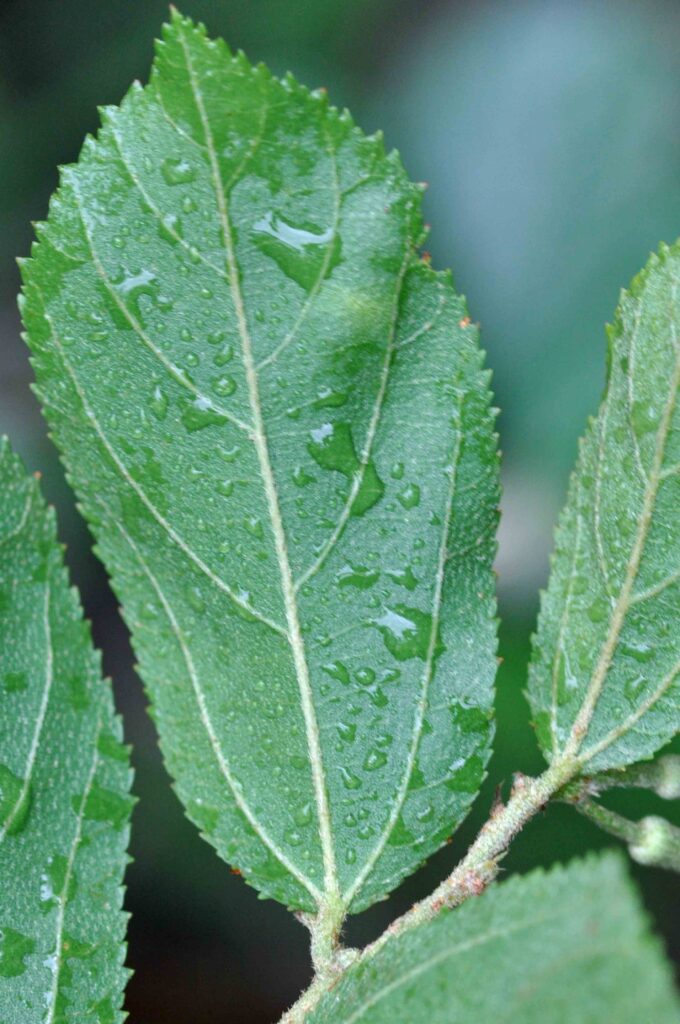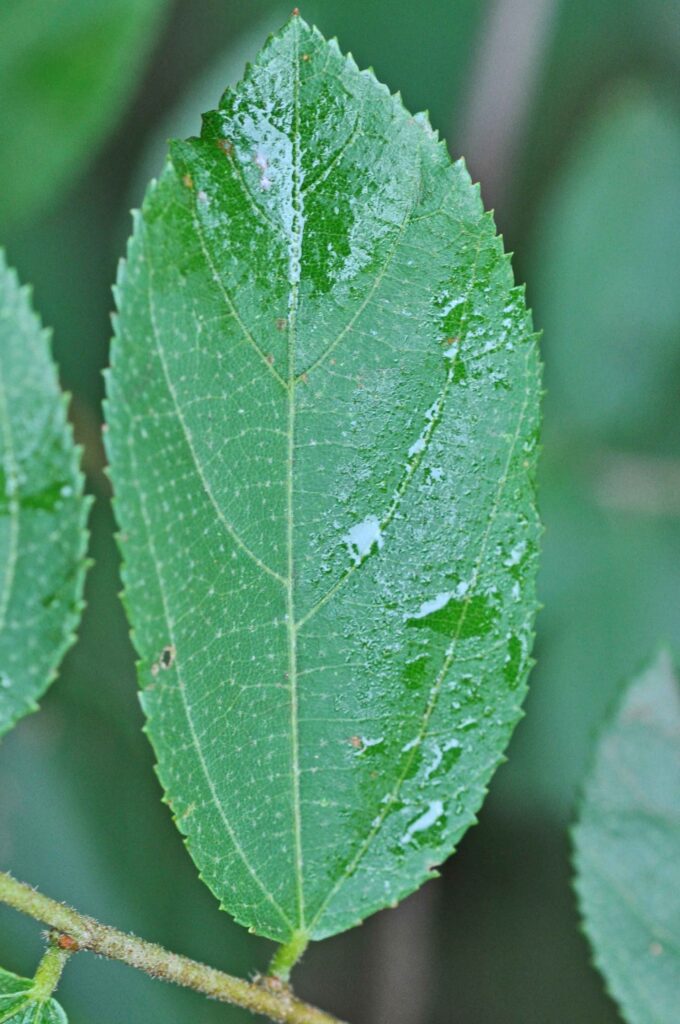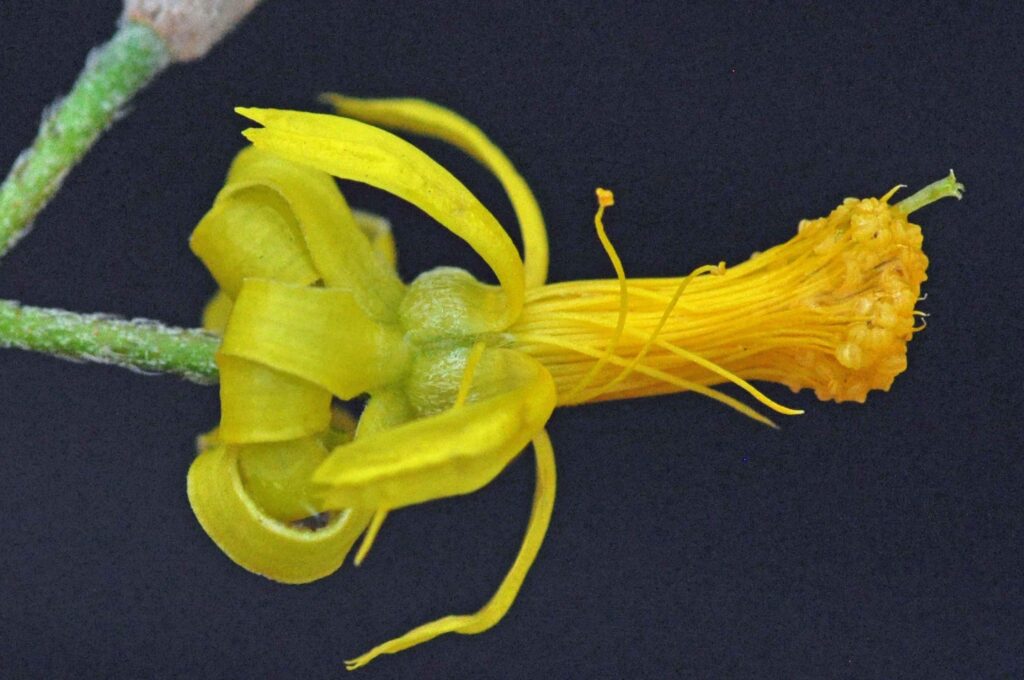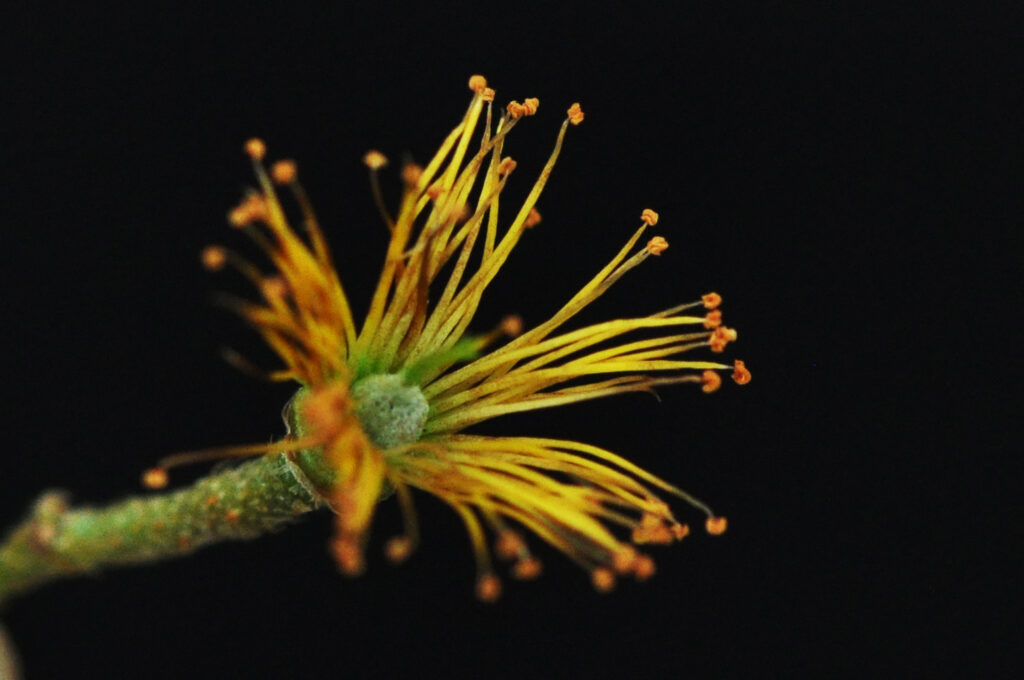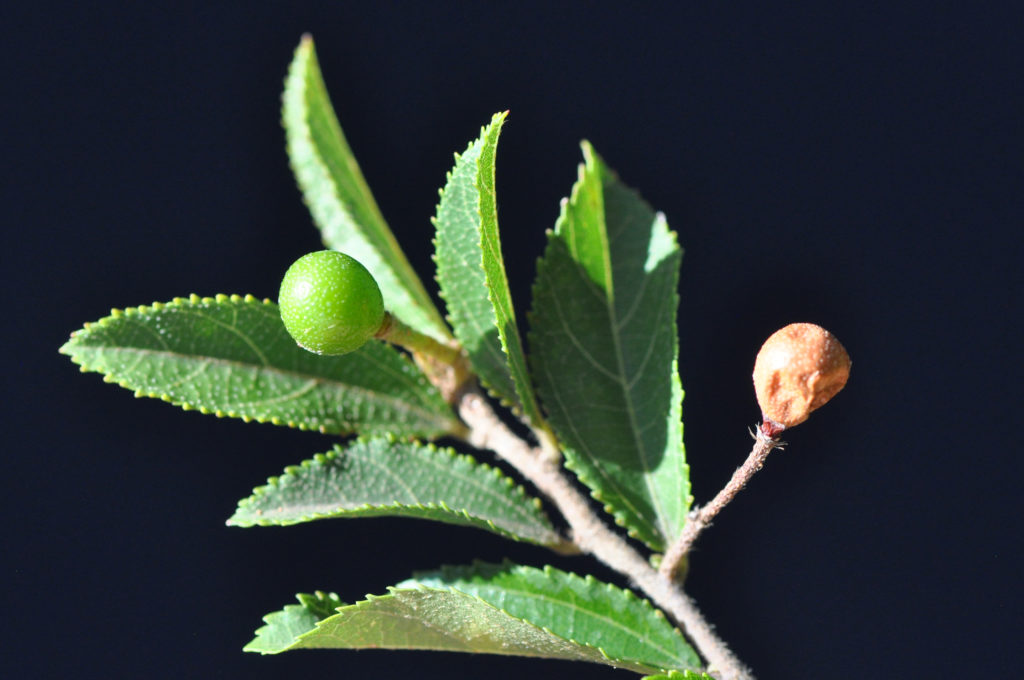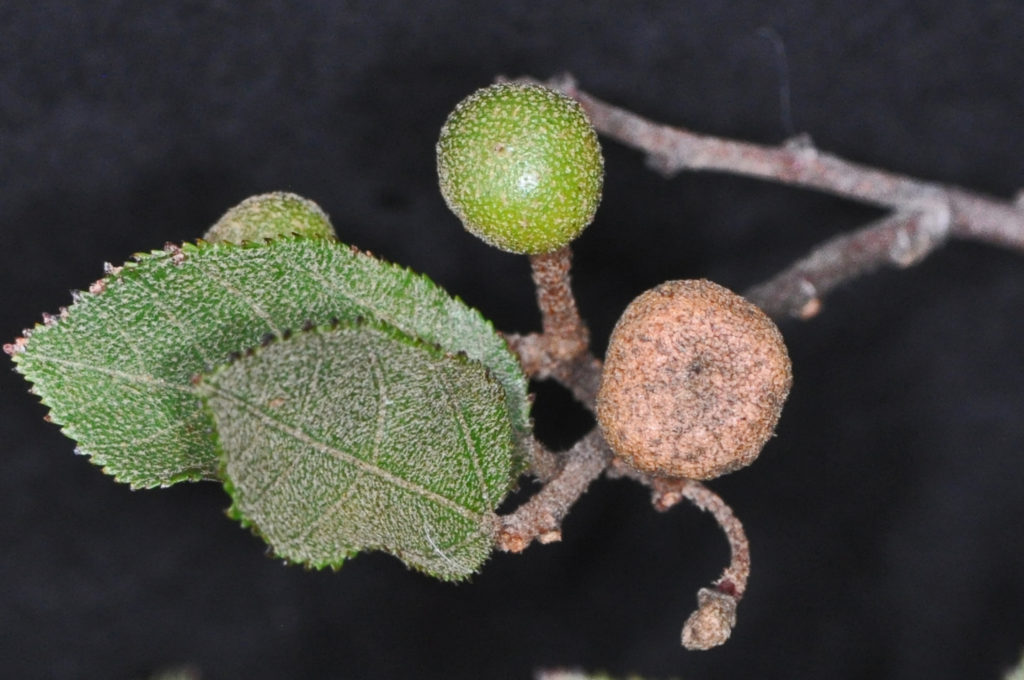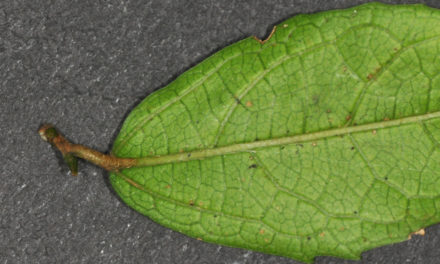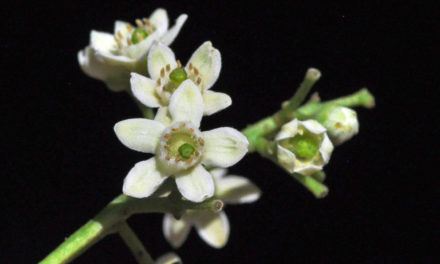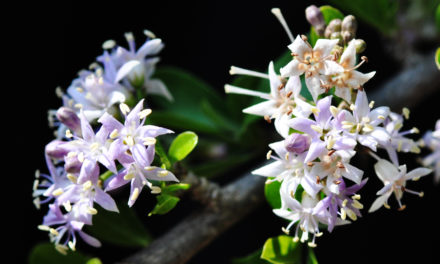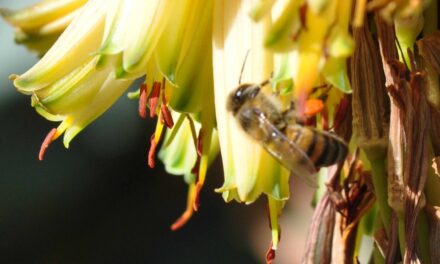General Info – summary
This deciduous, often multi-stemmed shrub, and may be a Tree to 6m high with 4-angled/grooved branches. Alternate, simple, variously shaped, light green Leaves with unevenly serrated margins are 3-veined from the base. Rough hairs are present. The yellow, bisexual, regular, 5-merous, stalked Flowers have many exserted stamens with yellow filaments and a single pistil. The small, edible Fruit a drupe.
Description
Grewia flavescens
Previous Names: Grewia flavescens var. longipedunculata.
SA Tree No. 459.2.
Common names: (Afr) Kruisbessie, Skurweblaarrosyntjie, Skurwerosyntjie. (Eng) Donkey Berry, Donkyeberry, Rough-leaved Raisin, Sandpaper Raisin. (IsiNdebele) Ubhuzu, Umnaba, Umtewa. (isiZulu) Ilalanyathi, Iklolo. (siSwati) liklolo, likloko. (Xitsonga) Mparachwene, Nsihana.
Family: Malvaceae. (Wild Pear, Gossypium – cotton, baobab and Hibiscus). This family has about 240 genera and 4 200+ species. Indigenous genera that have trees on this website includes Adansonia (baobab), Cola, Dombeya, Grewia, Hibiscus, Sparrmannia and Sterculia. The usually alternate Leaves of all members possess stipules and apart from Adansonia, remain simple. Flowers are regular, bisexual or unisexual and have 5 petals (Sparrmannia africana has 4). Petals are absent in Cola and Sterculia. There are 5 to many stamens with filaments often united into a staminal tube. Stamens surround the superior Ovary with its simple Style and capitate or lobed Stigma. Fruits are usually nuts, schizocarps or loculicidal capsules.
Name derivation: Grewia: named after an English pioneer plant anatomist and physiologist: Nehemiah Grew (1641–1712). flavescens – yellowish or becoming yellow – referring to the flower colour. The type specimen came from India. There are 27 species of Grewia in southern Africa.
Conservation: National Status: L C. (Least Concern). Assessment Date: 2005 (W. Foden and L. Potter).
Tree
This Tree may reach 6m high but it is often a shorter, multi stemmed, scrambling shrub. Bark is a dark grey-brown. The vertical, older Trunk (photo 114) and large branches are often clearly 4-angled, fluted, grooved or furrowed. Young green Branches have rough, cream coloured hairs, which are soon lost. Mature branches become smooth, 4-angled (photo 902) and may be deeply grooved. They turn brown with age. Visible Lenticels (a usually raised corky oval or elongated area on the plant that allows the uncontrolled interchange of gases with the environment – photo 609) are present. Grewia retinervis is similar but does not have 4-angled older stems.
- 626. 2018/01/30. Pretoria NBG. Photo: David Becking.
- 114. 2014/02/17. Marakele NP Photo: David Becking.
- 30. 2015.04.24 Witkoppen Nursery. Photo: David Becking.
- 609. 2018/01/30. Pretoria NBG. Photo: David Becking.
- 902. 2018/03/01. Pretoria NBG. Photo: David Becking.
Leaves
On this deciduous tree, the light green above and slightly paler below Leaves are simple (has a single blade which may have incisions that are not deep enough to divide the blade into leaflets). The leaf size is up to 12 x 9cm. Leaves have distinctly rough stellate hairs – especially below – hence the common name Sandpaper Raisin. The leaf shape is ovate, oblong or oblanceolate (the reverse of lanceolate, the leaf is broader at the apical third than at the middle and tapers towards the base). The alternate leaves (photo 610) are up to 12 x 9cm. The Apex just tapers or may end with a drip-tip. The veins are more clearly visible on the lower side (photos 606 & 604. From this side the 3-veined Base (round, lobed or square) is visible (photo 606). The base may be slightly asymmetric. The hairy Margin is irregularly serrate (saw-toothed margin with teeth pointing forward – photo 604). The longhaired but short Petiole (leaf stalk – photo 604) is usually up to 9mm long. Laterally appearing Stipules (basal appendages of the petiole) are hairy; up to 1cm long and caducous (easily detached and shed at an early stage – photo 604).
- 610. 2018/01/30. Pretoria NBG. Photo: David Becking.
- 606. 2018/01/30. Pretoria NBG. Photo: David Becking.
- 604. 2018/01/30. Pretoria NBG. Photo: David Becking.
Flowers
The yellow to golden and possibly fragrant Flowers arise towards the ends of branches from small, oblong buds situated in 2’s or 3’s on leaf axils (photo 610 – under Leaves). In this photo, the youngest buds are visible closest to the stem apex. Each flower rests on a hairy Pedicel (stalk of a single flower) that is up to 11mm long (photo 621) and each flower has a diameter up to 3cm and is slightly longer than this. Flowers are bisexual and actinomorphic (Regular, symmetrical. Flowers are vertically divisible into similar halves by more than 1 plane passing through the axis). The 5 free Sepals are strap-shaped and up to 3cm long. They are greenish yellow, externally hairy and may become strongly recurved (photo 621). Internally they are distinctively yellowish green and petal-like. The Corolla has 5 thinly yellow or golden Petals that are shorter than the sepals. A central mass of free Stamens with initially yellow filaments (photos 621 & 623) is present on an extended Receptacle (more or less enlarged or elongated end of the stem or flower axis on which all or some of the flower parts are borne). These numerous stamens surround the single Pistil (a unit of the Gynoecium, the female element of the flower, composed of the Ovary, Style and Stigma). Here the Ovary is superior. There is a single Style, which extends slightly beyond the stamens (photo 621). In this photo, the lobed green Stigma is visible. (Nov-Mar).
- 621. 2018/01/30. Pretoria NBG. Photo: David Becking.
- 623. 2018/08/30. Pretoria NBG. Photo: David Becking.
Fruit
Young green developing fruit (photo 623 under Flowers) is in the centre of the now leaning over the still yellow filaments with the now red anthers. In this photo, the green style is still visible. The small, shiny and hairy Fruit is a Drupe (a fleshy, 1-seeded indehiscent fruit with the Seed enclosed in a stony endocarp; stone fruit e.g. peach) up to 15mm in diameter. The fruit is usually slightly 2-4 lobed (photo 27) or almost spherical (photo 754). The fruit rests on a hairy Pedicel (stalk of a single flower) that is up to 2cm long (photo 27). A persistent Style may be visible. The fruit contains Pyrenes (nutlets in a drupe similar to peach pips). Each green shiny fruit shrinks and becomes reddish brown when mature (photo 27). At this stage a few long white hairs may be visible. (Mar-Jun).
- 754 2018.02.12 Pretoria NBG. Photo: David Becking.
- 27 2015.04.24 Witkoppen Nursery. Photo: David Becking.
Distribution & Ecology
These Plants are common below an altitude of 1 550m on rocky slopes, in bushveld (a sub-tropical woodland ecoregion of southern Africa), on termite mounds, riverine thickets and in soils rich in lime. They are also found in fertile alluvial soil where they may form dense thickets. Plants may be scandent (climbing without the aid of tendrils) and may grow in light shade areas. These plants are common in areas of low to medium rainfall. They are located from central to northern Kwazulu-Natal, Gauteng, Mpumalanga e.g., northern Kruger, Limpopo (largest location in SA), North West, Swaziland, Mozambique, Botswana, Namibia (central & north), Zimbabwe, Zambia, Malawi, Tanzania, northern and north-eastern Namibia, Arabia and India. The Fruit attracts many birds. Monkeys, warthogs, buck e.g., klipspringers and impalas, and baboons consume the fruit. Game, including the klipspringer and impala, browse the Leaves. They are also the food plants for the larvae of diurnal moth-like Skipper butterflies (named because of their quick, darting flight habits) in the family Hesperiidae with 3 000+ species occur worldwide. They serve as important pollinators and provide a good support for the ecosystem.
Ethnobotany
Stock and game browse the Leaves. The edible Fruit should have the dry skin rubbed off before consumption and the amount left is relatively small. Propagation is through cuttings (most successful) or from seeds that germinate best if they collected from dung. Plant seeds in a sunny place and expect to wait 2 years before flowering. This tree is hardy and can survive in almost any type of soil. In addition, it is frost and drought resistant. This is an attractive addition to a garden and may be used as a screen. Bows, sticks and knobkerries are made from the Wood. Young Branches are used for weaving baskets. This is a good plant for attracting birds. Local medicine makes use of this plant. Aids to identification include very rough leaves and square stems.
References
Boon, R. 2010. Pooley’s Trees of eastern South Africa. Flora and Fauna Publications Trust, Durban.
Burrows, J.E., Burrows, S.M., Lotter, M.C. & Schmidt, E. 2018. Trees and Shrubs Mozambique. Publishing Print Matters (Pty) Ltd. Noordhoek, Cape Town.
Coates Palgrave, M. 2002. Keith Coates Palgrave Trees of Southern Africa, edn 3. Struik, Cape Town.
Foden, W. & Potter, L. 2005. Grewia flavescens Juss. National Assessment: Red List of South African Plants version 2020.1. Accessed on 2023/06/30.
Lawrence, G. H. M, 1951. Taxonomy of Vascular Plants. The Macmillan Company, New York. Tenth Printing 1965.
Palmer, E. & Pitman, N. 1972. Trees of southern Africa. Balkema, Amsterdam, Cape Town.
Schmidt, S. Lotter, M. & McCleland, W. 2002. Trees and Shrubs of Mpumalanga and the Kruger National Park. Jacana, Johannesburg.
van Wyk, B. & van Wyk, P. 1997 Field guide to Trees of Southern Africa. Struik, Cape Town.
Robert H. Archer – help with ID.
http://pza.sanbi.org/grewia-flavescens
http://www.zimbabweflora.co.zw/speciesdata/species.php?species_id=138440
http://posa.sanbi.org/flora/browse.php?src=SP

